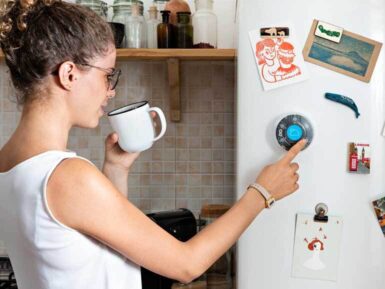
Grove - Speech Recognizer
The Grove speech recognizer is a module designed for application in the smart home, toy, robot or anything you would like to control with voice commands.
Overview
The board includes a Nuvoton ISD9160, a microphone, 1 SPI flash, 1 grove connector, 1 speaker connector and 1 led to show to your voice activity.
Nuvoton ISD9160 is (SoC) Chipcorder that based on Cortex™-M0, it provides performance and the energy efficiency needed for voice control applications. The microphone on grove-speech recognizer is Omni-directional.
This speech recognizer can recognize 22 commands including ‘start’, ‘stop’ and ‘Play music’. Every time it recognizes a command, it will return a value and the connected loudspeaker will repeat the command. This value can be used to control other devices like a motor or music player.
Note: The wake up word is “Hicell” (Pronounce it as one word). When it recognizes the awaken word the LED turns red and you can say the command word. If it recognize the command word, the LED will turn blue.
Note: The firmware of the module was wrote by the third party vendor, it’s not open source.
Application Ideas:
- Internet of Things
- Smart House
- Human Machine Interface
- Lighting Control
- Sensor Hub
- Robot
Features:
- Local Voice Recognition
- Very low rate of false triggering
- Speaker connector(JST2.0, speaker is not include)
- Built-in microphone
- 3.3/5V working voltage
- 22 recognition entry
- Default Baudrate: 9600
Tech specs
Specification
|
Item |
Min |
Typ |
Max |
Condition |
|
Operating Voltage |
3V |
3.3V |
5V |
25 ℃ |
|
Operating Current |
25mA |
26.5mA |
80mA@playing |
VCC = 3.3V 25℃ |
|
Operating Current |
25mA |
26.5mA |
130mA@playing |
VCC = 5V 25℃ |
|
Operating Temperature |
0℃ |
25℃ |
85℃ |
|
|
Size |
40*20mm |
|||
|
Weigth |
5g |
|||
|
Flash |
2Mbytes |
|||
|
Microphone Sensitivity |
-43dB |
-40dB |
-37dB |
VCC = 5V 25℃ |
|
Microphone SNR |
58dB |
|||
|
Microphone Directivity |
Omni-directional |
|||
|
Speaker Power |
1W |
VCC = 5V 25℃ |
||
|
Processor core |
Cortex-M0 |
|||
|
Processor Frequency |
32.768MHz |
50MHz |
VCC = 5V 25℃ |
Get Inspired
Weather forecast for 7 days and current (local) weather data displayer using the Arduino Opla IoT Kit

We’re excited to announce the launch of the Arduino Oplà Kit, the first open programmable IoT platform that allows you to add smart connectivity to the devices around your home or workplace and build custom IoT devices. The Oplà IoT Kit contains all the hardware necessary to create eight connected applications, access to an online platform with assembly instructions, and a 12-month subscription to the Arduino Create Maker Plan. This kit is perfect for beginners with basic DIY experience, while more advanced users can leverage it to customize and hack their smart applications and devices, with full control of their data and processes. Eight out-of-the-box projects to connect your home or workplace The projects included in the Oplà IoT Kit enable users to turn everyday appliances into smart appliances, which can be controlled remotely on a mobile phone: Remote Controlled Lights — Change color, light modes, and switch on/offPersonal Weather Station — Record and monitor local weather conditionsHome Security Alarm — Detect motion and trigger warningsSolar System Tracker — Retrieve data from planets and moons in the solar systemInventory Control — Track goods in and outSmart Garden — Monitor and manage the environment for your plantsThermostat Control — Smart control for heating and cooling systemsThinking About You — Send messages between the kit and the Arduino IoT Cloud Create, connect, control. The Internet of Things has never been so easy! No soldering is required with the Oplà IoT Kit, which is based on a MKR IoT carrier with an OLED color display, on-board environmental sensors, and capacitive touch buttons. The kit also includes a MKR WiFi 1010 board, a circular plastic enclosure and supporting accessories, such as two cables, a motion sensor, a moisture sensor, and a USB cable. To build applications, users can rely on the Oplà online platform. Each project includes goals, an intro to the components,





